ARCHIVED - Canada's Energy Future * - Reference Case and Scenarios to 2030 - Energy Market Assessment
This page has been archived on the Web
Information identified as archived is provided for reference, research or recordkeeping purposes. It is not subject to the Government of Canada Web Standards and has not been altered or updated since it was archived. Please contact us to request a format other than those available.
November 2007
* This edition of Canada's Energy Future includes minor revisions and an expanded Appendices. The National Energy Board has issued an Errata for Canada's Energy Future, available on the National Energy Board web site at www.neb-one.gc.ca. Please refer to this Errata for details of significant revisions. The Board apologizes for any inconvenience caused by these changes.

Canada's Energy Future - Reference Case & Scenarios to 2030 - Energy Market Assessment [PDF 4103 KB]
Canada's Energy Future - Reference Case & Scenarios to 2030 - Energy Market Assessment - Report and Appendices [ZIP 7185 KB]
(Maintains links between report charts and their associated data, and between appendices and data files.)
Table of Contents
List of Figures
List of Tables
List of Acronyms and Abbreviations
List of Units
Executive Summary
Analytical Overview
Overview of Reference Case and Scenarios
Overview of Key Assumptions and Quantitative Results
Conclusions
Foreword
Chapter 1: Introduction
Canada's Energy Future: The 2007 Approach
Scenarios Used in This Report
Stakeholder Input
Report Structure
Chapter 2: Energy Context
Price of Energy
Global Context
Energy and Environmental Policy Developments
Demand Response
New and Emerging Technologies
Infrastructure
Energy in the Canadian Economy
Energy Exports
Canadian Reserves
Chapter 3: Reference Case
Reference Case Overview (2005-2015)
Macroeconomic Outlook
Energy Prices
Energy Demand
Oil Supply
Natural Gas Supply
Natural Gas Liquids
Electricity Supply
Coal
Greenhouse Gas Emissions
Reference Case Issues and Implications
Chapter 4: Continuing Trends
Scenario Overview (2005-2030)
Macroeconomic Outlook
Energy Prices
Energy Demand
Oil Supply
Natural Gas Supply
Natural Gas Liquids
Electricity Supply
Coal
Greenhouse Gas Emissions
Continuing Trends Issues and Implications
Chapter 5: Triple E
Scenario Overview(2005-2030)
Macroeconomic Outlook
Energy Prices
Energy Demand
Oil Supply
Natural Gas Supply
Natural Gas Liquids
Electricity Supply
Coal
Greenhouse Gas Emissions
Triple E Issues and Implications
Scenario Overview (2005-2030)
Macroeconomic Outlook
Energy Prices
Energy Demand
Oil Supply
Natural Gas Supply
Natural Gas Liquids
Electricity Supply
Coal
Greenhouse Gas Emissions
Fortified Islands Issues and Implications
Chapter 7: Conclusions: Key Implications for the Canadian Energy System
Glossary
Conversion Tables
Guide to Appendices
List of Figures
| ES.1 | Canadian Total Secondary Energy Demand |
| ES.2 | Canadian GHG Emissions Intensity |
| AO.1 | Annual Average Growth Rate of Real GDP, Labour Force and Productivity - Reference Case 2004-2015 and Scenarios 2004-2030 |
| AO.2 | Annual Average Growth Rate of Goods Producing Sector, Service Sector and Personal Disposable Income - Reference Case 2004-2015 and Scenarios 2004-2030 |
| AO.3 | Regional Composition of GDP, 2004 and 2030 |
| AO.4 | West Texas Intermediate Crude Oil Price at Cushing, Oklahoma |
| AO.5 | Natural Gas Price at Henry Hub, Louisiana |
| AO.6 | Canadian Total Secondary Energy Demand |
| AO.7 | Canadian Crude Oil Production Outlook |
| AO.8 | Canadian Light Crude Oil Exports |
| AO.9 | Canadian Heavy Crude Oil Exports |
| AO.10 | Canadian Natural Gas Production Outlook |
| AO.11 | Canadian Natural Gas Net Exports |
| AO.12 | Electric Generation by Fuel and Scenario |
| AO.13 | Canadian Coal Production and Disposition, 2005, 2015 and 2030 |
| AO.14 | Canadian Total GHG Emissions |
| AO.15 | Canadian GHG Emissions Intensity |
| 1.1 | NEB Energy Futures Scenarios |
| 2.1 | Global Production and Consumption of Oil and Gas by Area, 2006 |
| 2.2 | World Primary Energy Consumption by Fuel Type, 2006 |
| 2.3 | Estimated Proved Oil Reserves, 2005 |
| 3.1 | Real GDP Growth Rates - Reference Case 2004-2015 |
| 3.2 | West Texas Intermediate Crude Oil Price at Cushing, Oklahoma - Reference Case |
| 3.3 | Natural Gas Price at Henry Hub, Louisiana - Reference Case |
| 3.4 | Canadian Total Secondary Energy Demand Intensity - Reference Case |
| 3.5 | Canadian Residential Secondary Energy Demand by Fuel - Reference Case |
| 3.6 | Canadian Commercial Secondary Energy Demand by Fuel - Reference Case |
| 3.7 | Canadian Industrial Secondary Energy Demand by Fuel - Reference Case |
| 3.8 | Canadian Transportation Energy Demand by Fuel - Reference Case |
| 3.9 | Canadian Transportation Energy Demand by Mode - Reference Case |
| 3.10 | Total Canada Oil Production - Reference Case |
| 3.11 | WCSB Conventional Oil Production - Reference Case |
| 3.12 | Eastern Canada Light Crude Production - Reference Case |
| 3.13 | Canadian Oil Sands Production - Reference Case |
| 3.14 | Supply and Demand Balance, Light Crude Oil - Reference Case |
| 3.15 | Supply and Demand Balance, Heavy Crude Oil - Reference Case |
| 3.16 | Natural Gas Production Outlook - Reference Case |
| 3.17 | Supply and Demand Balance, Natural Gas - Reference Case |
| 3.18 | Canadian Ethane Supply and Demand Balance - Reference Case |
| 3.19 | Canadian Generating Capacity - Reference Case |
| 3.20 | Canadian Generation - Reference Case |
| 3.21 | Interprovincial Transfers and Net Exports - Reference Case |
| 3.22 | Canadian Total GHG Emissions by Sector - Reference Case |
| 3.23 | Canadian Total GHG Intensity - Reference Case |
| 4.1 | Real GDP Growth Rates - Continuing Trends 2004-2030 |
| 4.2 | West Texas Intermediate Crude Oil Price at Cushing, Oklahoma - Continuing Trends |
| 4.3 | Natural Gas Price at Henry Hub, Louisiana - Continuing Trends |
| 4.4 | Canadian Total Secondary Energy Demand by Fuel - Continuing Trends |
| 4.5 | Canadian Total Secondary Energy Demand Intensity - Continuing Trends |
| 4.6 | Canadian Residential Secondary Energy Demand by Fuel - Continuing Trends |
| 4.7 | Canadian Commercial Secondary Energy Demand by Fuel - Continuing Trends |
| 4.8 | Canadian Industrial Secondary Energy Demand by Fuel - Continuing Trends |
| 4.9 | Canadian Transportation Energy Demand by Fuel - Continuing Trends |
| 4.10 | Canadian Transportation Energy Demand by Mode - Continuing Trends |
| 4.11 | Total Canada Oil Production - Continuing Trends |
| 4.12 | WCSB Conventional Oil Production - Continuing Trends |
| 4.13 | Eastern Canada Light Crude Production - Continuing Trends |
| 4.14 | Canadian Oil Sands Production - Continuing Trends |
| 4.15 | Supply and Demand Balance, Light Crude Oil - Continuing Trends |
| 4.16 | Supply and Demand Balance, Heavy Crude Oil - Continuing Trends |
| 4.17 | Natural Gas Production Outlook - Continuing Trends |
| 4.18 | Supply and Demand Balance, Natural Gas - Continuing Trends |
| 4.19 | Canadian Ethane Supply and Demand Balance - Continuing Trends |
| 4.20 | Canadian Generating Capacity - Continuing Trends |
| 4.21 | Canadian Generation - Continuing Trends |
| 4.22 | Interprovincial Transfers and Net Exports - Continuing Trends |
| 4.23 | Canadian Total GHG Emissions by Sector - Continuing Trends |
| 4.24 | Canadian Total GHG Intensity - Continuing Trends |
| 5.1 | Real GDP Growth Rates - Triple E 2004-2030 |
| 5.2 | West Texas Intermediate Crude Oil Price at Cushing, Oklahoma - Triple E |
| 5.3 | Natural Gas Price at Henry Hub, Louisiana - Triple E |
| 5.4 | Canadian Total Secondary Energy Demand by Fuel - Triple E |
| 5.5 | Canadian Total Secondary Energy Demand Intensity - Triple E |
| 5.6 | Canadian Residential Secondary Energy Demand by Fuel - Triple E |
| 5.7 | Canadian Commercial Secondary Energy Demand by Fuel - Triple E |
| 5.8 | Canadian Industrial Secondary Energy Demand by Fuel - Triple E |
| 5.9 | Canadian Transportation Energy Demand by Fuel - Triple E |
| 5.10 | Canadian Transportation Energy Demand by Mode - Triple E |
| 5.11 | Total Canada Oil Production - Triple E |
| 5.12 | Alberta Backbone CO2 Pipeline Schematic |
| 5.13 | WCSB Conventional Oil Production - Triple E |
| 5.14 | Eastern Canada Crude Production - Triple E |
| 5.15 | Canadian Oil Sands Production - Triple E |
| 5.16 | Supply and Demand Balance, Light Crude Oil - Triple E |
| 5.17 | Supply and Demand Balance, Heavy Crude Oil - Triple E |
| 5.18 | Natural Gas Production Outlook - Triple E |
| 5.19 | Supply and Demand Balance, Natural Gas - Triple E |
| 5.20 | Canadian Ethane Supply and Demand Balance - Triple E |
| 5.21 | Canadian Generating Capacity - Triple E |
| 5.22 | Canadian Generation - Triple E |
| 5.23 | Interprovincial Transfers and Net Exports - Triple E |
| 5.24 | Canadian Total GHG Emissions by Sector - Triple E |
| 5.25 | Canadian Total GHG Intensity - Triple E |
| 6.1 | Real GDP Growth Rates - Fortified Islands 2004-2030 |
| 6.2 | West Texas Intermediate Crude Oil Price at Cushing, Oklahoma - Fortified Islands |
| 6.3 | Natural Gas Price at Henry Hub, Louisiana - Fortified Islands |
| 6.4 | Canadian Total Secondary Energy Demand by Fuel - Fortified Islands |
| 6.5 | Canadian Total Secondary Energy Demand Intensity - Fortified Islands |
| 6.6 | Canadian Residential Secondary Energy Demand by Fuel - Fortified Islands |
| 6.7 | Canadian Commercial Secondary Energy Demand by Fuel - Fortified Islands |
| 6.8 | Canadian Industrial Secondary Energy Demand by Fuel - Fortified Islands |
| 6.9 | Canadian Transportation Energy Demand by Fuel - Fortified Islands |
| 6.10 | Canadian Transportation Energy Demand by Mode - Fortified Islands |
| 6.11 | Total Canada Oil Production - Fortified Islands |
| 6.12 | WCSB Conventional Oil Production - Fortified Islands |
| 6.13 | Eastern Canada Light Crude Production - Fortified Islands |
| 6.14 | Canadian Oil Sands Production - Fortified Islands |
| 6.15 | Supply and Demand Balance, Light Crude Oil - Fortified Islands |
| 6.16 | Supply and Demand Balance, Heavy Crude Oil - Fortified Islands |
| 6.17 | Natural Gas Production Outlook - Fortified Islands |
| 6.18 | Supply and Demand Balance, Natural Gas - Fortified Islands |
| 6.19 | Canadian Ethane Supply and Demand Balance - Fortified Islands |
| 6.20 | Canadian Generating Capacity - Fortified Islands |
| 6.21 | Canadian Generation - Fortified Islands |
| 6.22 | Interprovincial Transfers and Net Exports - Fortified Islands |
| 6.23 | Canadian Total GHG Emissions by Sector - Fortified Islands |
| 6.24 | Canadian Total GHG Intensity - Fortified Islands |
List of Tables
| AO.1 | Summary of Key Assumptions and Quantitative Results |
| 2.1 | Canadian Coal Resources |
| 3.1 | Key Macroeconomic Variables - Reference Case 2004-2015 |
| 4.1 | Key Macroeconomic Variables - Continuing Trends 2004-2030 |
| 5.1 | Key Macroeconomic Variables - Triple E 2004-2030 |
| 6.1 | Key Macroeconomic Variables - Fortified Islands, 2004-2030 |
List of Acronyms and Abbreviations
| ACCA | Accelerated Capital Cost Allowance |
| ACR | Advanced CANDU reactor |
| EUB | Alberta Energy and Utilities Board |
| API | American Petroleum Institute |
| CANDU | Canadian Deuterium (nuclear reactor) |
| CANMET | Canada Centre for Mineral and Energy Technology |
| CAODC | Canadian Association of Oilwell Drilling Contractors |
| CBIP | Commercial Building Incentive Program |
| CBM | Coalbed methane |
| CCS | Carbon dioxide capture and storage |
| CETC | CANMET Energy Technology Centre |
| CFL | Compact fluorescent light bulb |
| CHP | Combined heat and power |
| CNG | Compressed natural gas |
| CO | Carbon monoxide |
| CO2 | Carbon dioxide |
| CSS | Cyclic steam stimulation |
| CVT | Continuously variable transmission |
| DSM | Demand-side management |
| EGH | EnerGuide for Houses |
| EMA | Energy Market Assessment |
| GDP | Gross Domestic Product |
| GeoPOS | GeoPower in the Oil Sands |
| GHG | Greenhouse gas |
| GSC | Geological Survey of Canada |
| H2 | Hydrogen gas |
| ICE | Internal combustion engine |
| IEA | International Energy Agency |
| IEEP | Incremental Ethane Extraction Policy |
| IGCC | Integrated Gasification Combined Cycle |
| IOR | Improved Oil Recovery |
| IPCC | Intergovernmental Panel on Climate Change |
| LEED® | Leadership in Energy and Environmental Design |
| LNG | Liquefied natural gas |
| MNECB | Model National Energy Code for Buildings |
| MSAR | Multiphase Superfine Atomized Residue |
| NAFTA | North American Free Trade Agreement |
| NEB | National Energy Board |
| NGL | Natural gas liquid |
| NIT | Nova Inventory Transfer |
| NOx | Nitrogen oxides |
| NRCan | Natural Resources Canada |
| NYMEX | New York Mercantile Exchange |
| OECD | Organization for Economic Cooperation and Development |
| OPEC | Organization of the Petroleum Exporting Countries |
| PIHV | Plug-in hybrid vehicle |
| PM | Particulate matter |
| R, D & D | Research, development and demonstration |
| RFO | Residual fuel oil |
| SAGD | Steam assisted gravity drainage |
| SOx | Sulphur oxides |
| StatCan | Statistics Canada |
| SUV | Sport Utility Vehicle |
| THAITM | Toe-to-heel air injection |
| UPS | Uninterruptible power supply |
| U.S. | United States |
| VAPEX | Vapourized extraction |
| VKT | Vehicle kilometres traveled |
| VOCs | Volatile organic compounds |
| WCS | Western Canadian Select |
| WCSB | Western Canada Sedimentary Basin |
| WTI | West Texas Intermediate |
List of Units
| bbl | barrels |
| b/d | barrels per day |
| Bcf | billion cubic feet |
| Bcf/d | billion cubic feet per day |
| GJ | gigajoule |
| GW | gigawatt |
| GW.h | gigawatt hour |
| kW.h | kilowatt hour |
| m³ | cubic metre |
| m³/d | cubic metres per day |
| Mb/d | thousand barrels per day |
| Mcf | thousand cubic feet |
| Mcf/d | thousand cubic feet per day |
| MMb/d | million barrels per day |
| MMBtu | million British thermal units |
| Mt | megatonne |
| MW | megawatt |
| $ or Cdn$ | Canadian dollars |
| US$ | U.S. dollars |
| Tcf | trillion cubic feet |
| TW.h | terawatt hour |
Executive Summary
Energy has and always will be extremely important to Canadians. With our northern climate, huge land mass and vast natural resources, we use energy to heat our homes, provide transport, develop our resources and produce goods and services. Energy is essential to our comfort and our economic prosperity.
At the same time, there is growing awareness of the consequences of energy use to our physical environment, the air quality in our cities, our health and the potential impact on the climate of our planet. Finding ways to produce and use energy that minimize the impacts on our environment is one of the key challenges Canadians face in the 21st century.
This report, Canada's Energy Future, allows the National Energy Board (NEB or Board) to communicate with Canadians about energy issues. Providing this information is part of the NEB's overall goal that Canadians benefit from efficient energy infrastructure and markets.
Canada's Energy Future highlights the issues Canadians face with respect to energy, as well as brings to light future implications for Canadian energy producers and consumers.
While the report focuses on trends in energy supply and demand, it does not offer specific policy direction as to what programs or actions would be required to meet certain objectives. It is up to us as Canadians, the energy industry and policy-makers to determine the desired outcome and the tools required to get us there. It is our hope that this report will be a positive contribution to the growing discussion many Canadians are having about energy and our environment.
The report examines different possible energy futures that may unfold for Canadians up to the year 2030. This includes a baseline projection, called the Reference Case, which is the Board's view of the most likely outcome up to the year 2015. Three different scenarios, each with its own internally consistent set of assumptions, such as economic growth, action on environmental issues and energy prices, are then used to examine Canada's energy future to 2030:
- Continuing Trends Scenario: Trends that are apparent at the beginning of the outlook period are maintained throughout the entire forecast and extend the Reference Case over the long-term.
- Triple E Scenario: A balancing of economic, environmental and energy objectives means this scenario has well-functioning energy markets, cooperative international agreements and the most rigorous energy demand management policies of the three scenarios.
- Fortified Islands Scenario: Security concerns dominate this scenario with geopolitical unrest, a lack of international cooperation and trust, and protectionist government policies.
The main findings of this report are as follows:
Energy demand in Canada will continue to grow for the next 30 years.
- Energy demand will remain primarily a function of population and economic growth. With these two factors on the rise, energy demand is growing (Figure ES.1). The way Canadians use energy will change, but slowly. This is because our office buildings, homes and vehicles are not replaced or upgraded on a regular basis to take advantage of the latest energy efficient technologies. Over the long-term, there will be opportunities for Canadians to reduce their energy demand as improvements in energy efficiency and technology take effect.
Figure ES.1
Canadian Total Secondary Energy Demand
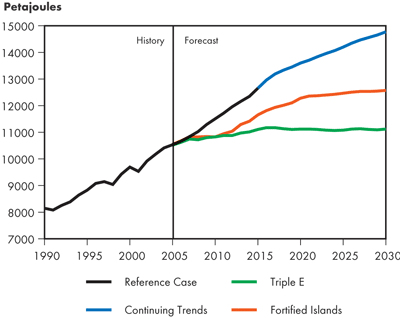
- Canadians will continue to use automobiles for personal transportation. Although these vehicles are becoming more energy efficient, they will still rely primarily on fossil fuels.
- Energy efficiency across the economy will continue to improve. The rate of improvement will depend on government policies and Canadians' commitment to managing the growth in energy demand.
- There will be a continued demand for natural gas including the need for gas in oil sands processing and electricity generation. However, there is also a move toward gas alternatives including substitution to other forms of energy and improved efficiency. This is especially true in the Triple E Scenario.
Canadians will have enough energy supplies in the forecasted future.
- Fossil fuels will continue to be the dominant source of energy supply for Canadians through to 2030. New emerging technologies and renewable energy resources, such as wind power and small hydro power projects, will be increasingly used.
- Oil sands production will grow in all three scenarios and the production will contribute to increased exports and Canadian economic growth. Large volumes of crude coming from the oil sands will be moved to market and will require appropriate infrastructure to do so.
- Natural gas production from the Western Canada Sedimentary Basin (WCSB) will decline. In fact, in two of the three scenarios, total natural gas production declines. However, there are opportunities for development of gas reserves in northern and offshore regions.
- Imports of liquefied natural gas (LNG) will increase in both the Continuing Trends and Triple E Scenarios. In the Triple E Scenario, LNG imports will account for half of Canada's gas needs by 2030.
Controlling greenhouse gas (GHG) emissions will be challenging.
- In the three scenarios studied, GHG emissions increase or decline slightly. In the Continuing Trends and Fortified Islands Scenarios, GHG emissions increase as a result of continued economic and energy demand growth. Under the Triple E Scenario, GHG emissions decline modestly as a result of energy demand management programs. Further changes by Canadians in lifestyle choices and more ambitious energy reduction programs, will be required to achieve additional reductions in GHG emissions.
- In order to achieve the Canadian government's target of a 20 percent reduction in GHG emissions by 2020, the full spectrum of GHG reduction strategies will need to be considered. Elements of solution, amongst others, will be found in agriculture and forestry carbon sinks and international emissions trading. This report, being focused on energy in Canada, did not seek to analyze these broader strategies.
GHG emission intensity is declining.
- Overall GHG emission intensity in Canada is declining. This means fewer GHG emissions to produce the same amount of goods and services (Figure ES.2). The future rate of decline differs depending on the policies and programs that are adopted.
Figure ES.2
Canadian GHG Emissions Intensity
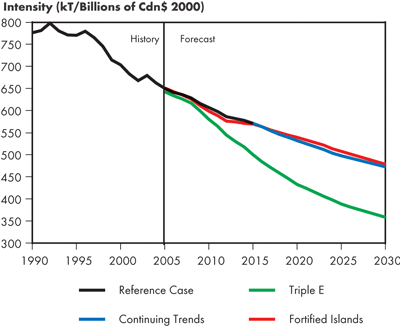
Getting key buildings blocks in place will help to meet future challenges and take advantage of opportunities in the energy sector.
- Technology can offer solutions to many challenges that we face today. The type of technology choice will depend on the scenario that will unfold in the future. Seizing technology opportunities requires a combination of market mechanisms and incentives.
- The markets will continue to work well, balancing energy demand and supply. However, a 'smart' policy is needed to help optimize the multiple objectives of economic growth, environmental sustainability, and responsible development of the energy sector. A proactive approach will be important due to the wide regional differences with respect to energy and emissions, evolving energy supply systems, and a changing global environment.
- Major investments are needed in the near future to develop new sources of energy and meet the growth in energy demand as well as replace the ageing infrastructure. With our abundant supply of energy, including northern and offshore resources and wind power, infrastructure is needed to bring it to market. There will also be a need for increased infrastructure between provinces for electricity generation. The infrastructure investments will require public engagement, buy-in and acceptance for these initiatives.
- Appropriate and adequate analysis of energy issues will continue to guide decision making. Such analysis is prefaced on high quality data.
Conclusion
The debate in Canada over the future of Canada's energy resources and our environment is growing. As Canadians plan for the future, they will face many decisions about what kind of a lifestyle they want to live and how that lifestyle reflects the broader issues impacting Canada's economy and environment.
A long-term energy vision and strategy for Canada is needed to balance multiple objectives. This plan must be well integrated at the regional level, consider environmental issues and economic growth, and be developed with input from Canadians. Only then will we be able to overcome the challenges ahead and take advantage of the opportunities available.
The NEB plans to contribute to this debate by continuing to pursue our vision of being an active, effective and knowledgeable partner engaging Canadians in the discussion of Canada's energy future.
Analytical Overview
This section provides an overview of the quantitative results contained within the report. A more detailed exploration of these results is discussed in subsequent chapters. As well, detailed provincial data tables can be found in the appendices.
Energy issues have an important influence on the lives of Canadians and have become more important in recent years. Rapidly increasing energy prices have given rise to concerns about whether or not energy supply will remain available in sufficient quantities and at reasonable prices. These energy security concerns are underpinned by international geopolitical tensions and conflicts, the apparent peaking of conventional resources in some parts of the world, and a rapid increase in global energy demand due to the pace of growth in developing countries. Furthermore, as evidence of the environmental impacts of energy production and use mount, Canadians are also paying greater attention to the sustainability of the energy system.
In response to these issues, the National Energy Board (NEB or the Board) has developed the latest in its series of long-term energy demand and supply outlooks. Canada's Energy Future depicts the analytical results of four different energy demand and supply cases representing the period 2005 to 2030. The report presents possible energy futures only and does not predict outcomes of regulatory decisions by the Board. The Board presents these cases to enable Canadians to discuss Canada's energy future.
Overview of Reference Case and Scenarios
Reference Case (2005-2015)
The Reference Case is a medium-term outlook for the time period 2005 to 2015. The Reference Case is the NEB's view of the most likely development of energy demand and supply over the immediate decade, assuming current energy market trends, the macroeconomic outlook, assumed energy prices and the existing suite of government programs. Overall energy production, consumption, and greenhouse gas (GHG) emissions continue to grow.
Long-Term Scenarios (2005-2030)
The other three cases are alternative long-term scenarios, which endeavour to capture a broader range of energy system outcomes. The analysis for these three cases covers the period from 2005 to 2030. Long lead times for project development and stock turnover imply that for differences in outcomes to occur by 2030, key decisions need to be taken early. Therefore, the scenario analysis begins in 2005 and overlaps the Reference Case period. The three scenarios are:
- Continuing Trends, which is characterized by the maintenance of significant trends apparent at the beginning of the outlook period through the forecast period. This scenario is one of little change. In Continuing Trends, Canada experiences the most rapid economic growth and moderate oil and gas prices. As a result, energy demand, energy production and GHG emissions growth continue to be high.
- Triple E is characterized by well-functioning global energy markets, cooperative international agreements and effective environmental policies. The scenario seeks a balance of economic, environmental, and energy (Triple E) objectives. This scenario is the mid-case for Canadian economic growth, has the lowest oil and gas commodity prices, and includes numerous energy demand management programs and policies. Consequently, energy demand growth flattens. This is the lowest energy production scenario and GHG emissions decline.
- Fortified Islands is the scenario wherein national energy security concerns are emphasized. Geopolitical unrest, a lack of international cooperation and trust, and protectionist government policies characterize this scenario. Fortified Islands reflects the lowest Canadian economic growth and the highest oil and gas prices. This combination of factors ensures that this scenario has lower energy demand growth and lower GHG emissions growth than the Continuing Trends Scenario. It also results in the strongest domestic oil and gas production scenario.
Each of the scenarios provides value by exploring a plausible future. It is unlikely that any one of these scenarios would come true in its entirety. Canadians will probably see a future that contains elements of all the different scenarios.
Overview of Key Assumptions and Quantitative Results
Assumptions
Macroeconomic
Macroeconomic projections are a key driver in the report on Canada's Energy Future. Macroeconomic variables including economic growth, gross output, and personal disposable income are used to develop the supply and demand outlooks. The structure of the Canadian economy (i.e., goods production versus service sector) and the regional distribution of gross domestic product (GDP) will influence demand trends.
In the Reference Case, real GDP growth is 2.9 percent from 2004 to 2015[1] and ranges from 1.8 percent to 2.5 percent from 2004 to 2030 across the three scenarios (Figure AO.1). Long-term economic growth is dependent on labour force and productivity assumptions. The higher the labour force or productivity improvements, the higher the economic growth, with all other factors held constant. In addition, the macroeconomic forecasts are also strongly influenced by scenario storylines.
[1] The growth rate is the average annual growth rate with 2004 as the base year.
Figure AO.1
Annual Average Growth Rate of Real GDP, Labour Force and Productivity - Reference Case 2004-2015 and Scenarios 2004-2030
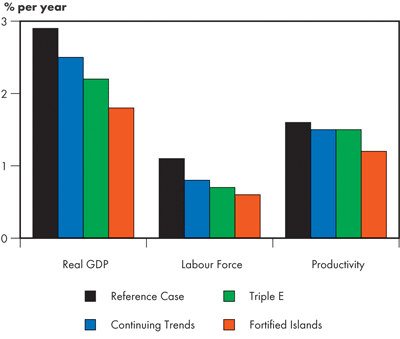
A common thread across the three scenarios is a notable deceleration of growth in the labour force, which intensifies over the long-term. This outcome is driven by demographic factors, such as an ageing population and lower birth rates. This results in slower average economic growth projections over all three scenarios than has been experienced in the recent past. Labour force growth varies between 0.6 percent and 1.1 percent over the Reference Case and scenarios (Figure AO.1). Altering levels of immigration across scenarios provide variations in the demography, but does not reverse overall trends. Productivity assumptions range between 1.2 percent and 1.6 percent. Productivity growth in the scenarios matches, or is modestly close to, growth in the recent past.
All factors considered, the Reference Case projects continued strong economic growth. This is maintained into Continuing Trends which reflects the highest economic growth of the three scenarios. Fortified Islands is the low economic growth scenario and Triple E falls in the middle. In 2030, the Triple E economy is 7 percent smaller and Fortified Islands is 10 percent smaller than the Continuing Trends economy.
Economic growth is linked to energy consumption. This is particularly evident in energy-intensive industries within the goods producing sector. In Continuing Trends and Triple E, the goods producing sector maintains its current share of GDP. Slower export demand for manufactured goods and marginally higher exchange rates in Fortified Islands lowers the goods producing share while the service sector share grows slightly.
Personal disposable income growth also influences energy demand trends, particularly in the residential sector and in personal transportation. Across the Reference Case and the scenarios, there is a range of personal disposable income growth rates that reflect the overall health of the respective economies (Figure AO.2).
Figure AO.2
Annual Average Growth Rate of Goods Producing Sector, Service Sector and Personal Disposable Income - Reference Case 2004-2015 and Scenarios 2004-2030
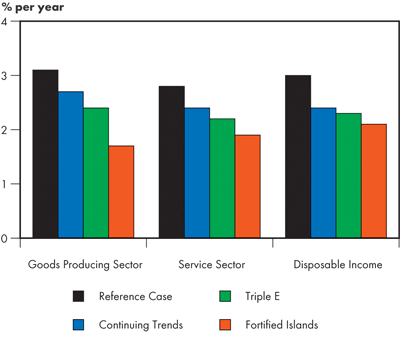
Some scenarios result in changes in the relative share of regional GDPs (Figure AO.3). In Continuing Trends, the share of regional GDP changes little from current shares. In Triple E, the shift in economic growth favouring central Canada is a result of relatively strong growth of manufacturing stemming from strong export demand. The opposite effect occurs in Fortified Islands where slow manufacturing export demand and high oil and gas prices hinder the manufacturing regions, but produce a boom in the oil and gas producing regions.
Figure AO.3
Regional Composition of GDP, 2004 and 2030
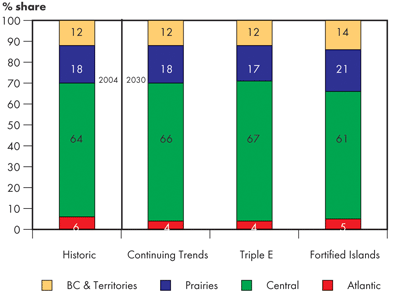
Energy Prices
The wide range of energy prices considered in Canada's Energy Future reflects the uncertainty of future prices (Figure AO.4 and AO.5). The West Texas Intermediate (WTI) crude oil price ranges from US$35.00 to US$85.00/barrel[2]. The Henry Hub price of natural gas ranges from US$5.25 to $11.40/GJ (US$5.50 to $12.00/MMBtu). Natural gas prices typically move in relation to crude oil prices over the long-term, although usually at a slight discount on an energy-equivalent basis, resulting in a natural gas to oil price ratio of around 0.84. Short-term fluctuations in this ratio can be quite wide. To reflect greater sensitivity to the lower carbon content of natural gas, the natural gas to crude oil price ratio increases to 0.94 in the Triple E Scenario.
[2] Prices are reported in US$2005 unless otherwise specified.
Figure AO.4
West Texas Intermediate Crude Oil Price at Cushing, Oklahoma
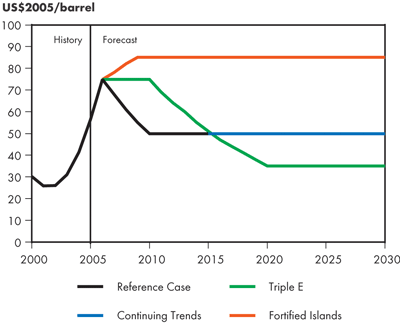
Figure AO.5
Natural Gas Price at Henry Hub, Louisiana
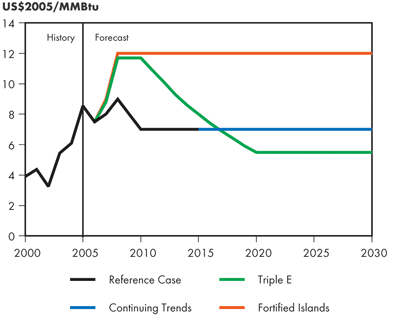
Quantitative Results
Energy Demand
Secondary Energy Demand
Total secondary (end-use) energy demand in Canada has increased an average of 1.8 percent per year from 1990 to 2004. This is maintained in the Reference Case scenario, with a growth rate of 1.8 percent from 2004 to 2015 (Figure AO.6). Despite the higher oil and gas prices in the outlook period, the expectation is that energy demand will remain robust as income and GDP continue to put upward pressure on demand for energy-related goods and services.
Figure AO.6
Canadian Total Secondary Energy Demand
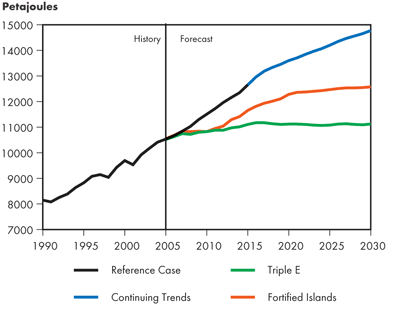
Growth in energy demand ranges from 0.3 percent to 1.4 percent per year across the three scenarios. As Continuing Trends extends the Reference Case out to 2030, the same assumptions apply, continuing the trends of the recent history into the future. As the forecast progresses to 2030, however, there is a slight slowdown in Canadian economic growth, personal disposable income and population, as described in the previous section. As a result, the energy demand growth rate for the Continuing Trends Scenario slows to 1.4 percent per year.
Economic growth and personal disposable income growth in Triple E is moderate. While commodity prices are lowest in this case, the assumed carbon dioxide (CO2) price drives up delivered fuel prices comparable to Continuing Trends. Thus, 'dual' pricing exists in this scenario, with producers facing the lower commodity price (Figure AO.4 and AO.5) and consumers seeing the higher delivered price[3]. Energy efficiency and environment influences are strongest in this case, with numerous government policies and programs assumed. This results in the slowest growth in Triple E, with an average annual growth rate of 0.3 percent per year from 2004 to 2030.
[3] The end-use or delivered price will vary by fuel. Details on end-use prices are contained in the appendices.
In Fortified Islands, total energy demand grows at 0.7 percent per year. This scenario is characterized by slower economic growth and higher commodity prices. This supports a deceleration in total energy demand compared to Continuing Trends and to historical rates due to the dampening income and price effect.
Energy Supply
Crude Oil
The crude oil production profiles developed for the Reference Case and the three scenarios result in a range of outcomes (Figure AO.7). All scenarios are characterized by declining conventional oil production in the Western Canada Sedimentary Basin (WCSB), moderate growth followed by rapid decline on the east coast offshore, and the increasingly dominant role of oil sands production.
Figure AO.7
Canadian Crude Oil Production Outlook
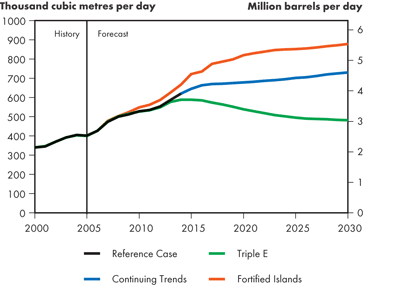
Both light and heavy conventional crude oil in the WCSB are in a long-term decline. This decline is somewhat softened by the influence of higher oil prices in the Fortified Islands Scenario and by government support for CO2-based improved oil recovery (IOR)[4] in the Triple E Scenario. The lower price in Triple E discourages development on marginal plays. Noticeable areas of impact include east coast offshore and oil sands. As a result, output declines in the latter half of the analysis timeframe. Conversely, high oil prices in Fortified Islands encourage development resulting in significant additional production.
[4] Increased oil recovery (IOR) is also referred to as enhanced oil recovery (EOR).
All scenarios reflect an increasing share of oil sands production.The mid-range oil price in the Reference Case and Continuing Trends Scenario is sufficient to support relatively high levels of oil sands development. The cost pressures currently experienced by oil sands developers are expected to moderate over time. Oil sands production growth is based on the assumption that there will be timely development of additional markets and pipeline capacity, as well as the sourcing of adequate supplies of condensate or other diluent for use as a blending agent for heavy oil. It is also assumed that industry can economically adopt future environmental obligations. To the extent that these assumptions are not realized, the projected levels of oil sands production may not be achieved.
As a result of declining volumes of light conventional crude and increasing oil sands output, the composition of the feedstock supply available to refineries is changing; therefore, refinery modifications will be required to process these new crude oil types. Refinery investments are highly capital-intensive and investment requires market certainty. The scenarios not only shape production volumes, but influence decisions on downstream processing and upgrading options. Although it is assumed there is always a market for all oil production, the share, or composition, of domestic product varies by scenario.
Total crude oil exports increase or remain at the current levels (Figure AO.8 and AO.9). Continuing Trends shows minor increases in domestic demand for light crude oil and some displacement of conventional light crude oil in the feedstock slate to synthetic crude oil. The Triple E Scenario shows a marginal decline in exports in the latter portion of the outlook period compared to the beginning of the outlook as a result of a slowing supply forecast. In Fortified Islands, the highest volume of exports is forecast with the possibility of Quebec refineries obtaining access to western Canadian crude oil. Overall, both light and heavy crude oil exports decline in the Triple E Scenario. In Fortified Islands, there is the highest growth in the three scenarios for both light and heavy crude oil exports. In the Continuing Trends Scenario, there is little change in the light crude oil exports over the forecast period and moderate growth in heavy oil exports. Overall, light crude oil exports exceed heavy oil exports in all scenarios.
Figure AO.8
Canadian Light Crude Oil Exports
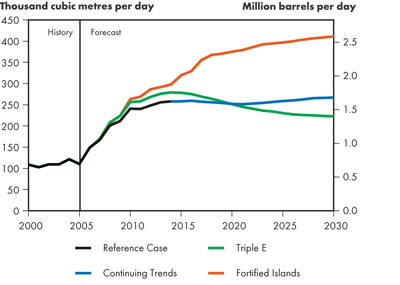
Figure AO.9
Canadian Heavy Crude Oil Exports
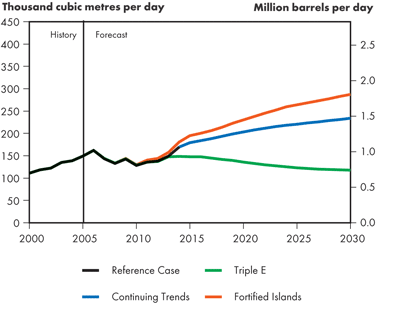
Natural Gas
The mid-range price in the Reference Case and Continuing Trends Scenario leads to gradual declines in Canadian natural gas production, while the high prices in Fortified Islands cause production to rise significantly (Figure AO.10). An influx of imported liquefied natural gas (LNG) in the Triple E Scenario maintains low prices, and ends up as the source for just over half of Canadian natural gas requirements by 2030. Liquefied natural gas imports are more modest in Continuing Trends and unavailable for much of the Fortified Islands Scenario.
Canadian natural gas demand also varies widely. Together, the demand and supply trends lead to a wide range of natural gas exports (Figure AO.11). Continuing Trends maintains similar growth in demand to recent years based on the strength of gas use for oil sands and electricity generation. The Continuing Trends outlook of increasing demand and gradually declining production reduces the net exports to zero by 2028, as more LNG enters Canada than conventional natural gas exported. In the later years of the outlook, Canada becomes a net gas importer, reliant on LNG imports[5].
[5] It should be noted that net gas exports is the amount of Canadian gas production in excess of Canadian natural gas consumption. Actual gas flows across Canada's international borders will exceed this value by any amounts of gas that are imported for consumption in Canada or that are imported for re-export.
Figure AO.10
Canadian Natural Gas Production Outlook
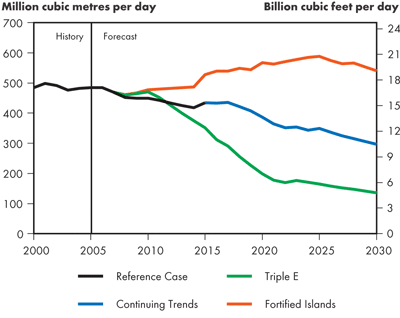
Figure AO.11
Canadian Natural Gas Net Exports
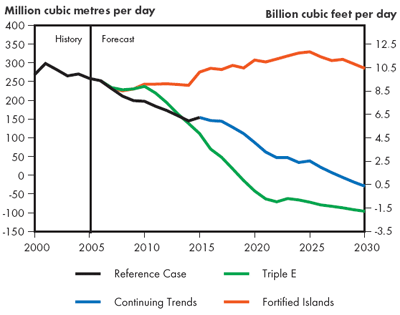
Total Canadian gas demand growth is lower in Triple E and Fortified Islands. In Triple E this is due to increased efficiency and lower demand for gas from oil sands projects; in Fortified Islands it is a result of higher energy prices and slower economic growth. In the Fortified Islands Scenario, the amount of potential net exports erodes slightly until 2015. At this point, frontier gas production comes on-stream and enables new records to be established for net annual natural gas exports.
Natural Gas Liquids
Projections of natural gas liquid (NGL) gas plant supplies are based on projections of natural gas production. These may be further augmented by liquids extracted from Mackenzie Delta gas, oil sands off-gas, as well as enhanced deep-cut expansion at Alberta straddle plants. Alaskan gas may begin to be imported into or transit Canada at some time before 2030. Depending on the configuration and contractual arrangements, natural gas liquids contained in an Alaska gas stream may potentially be extracted within Canada to supplement domestic supplies. An alternative concept might see Alaskan gas shipped as LNG and bypass Canada. As the timing, scale and configuration of a potential Alaskan gas project are highly uncertain at this point, Alaskan gas volumes have not been included in the projections.
Long-term ethane supply becomes less reliable in the forecast. By the end of the outlook period in both the Continuing Trends and Triple E Scenarios, ethane demand exceeds supply. This is a direct result of gas production decreases due to lower prices and continued growth in demand from the Alberta petrochemical sector. In Fortified Islands, ethane supply exceeds demand in the longer term owing to significant increments of supply from oil sands off-gas, straddle plant expansions and Mackenzie Delta gas.
Excess volumes of propane and butane are available for export throughout the projection period under all scenarios. However, under the Tripe E Scenario, the propane and butane supply and demand balance becomes tight near the end of the outlook period as lower commodity prices cause natural gas production to decrease.
Electricity
Significant changes are expected in the electricity supply sector, with many of them resulting from recent decisions on electricity generation and transmission (Figure AO.12). While conventional generation continues to provide the majority of energy in all scenarios, the emerging technologies begin to have a noticeable impact on the generation mix across Canada. In Ontario, existing coal plants are retired by 2015, replaced by a mixture of gas, nuclear, wind and other emerging technologies. Nuclear generation sees a renaissance in all three scenarios, as five new nuclear plants are constructed to replace retiring coal units and older nuclear plants. Emerging technologies are also used for coal-fired generation, with Integrated Gasification Combined Cycle (IGCC) becoming available after 2015. All scenarios assume an expanded use of bitumen for cogeneration in the Alberta oil sands. Since the amount of cogeneration is linked to oil sands production, cogeneration is highest in the Fortified Islands Scenario and lowest in Triple E.
Figure AO.12
Electric Generation by Fuel and Scenario
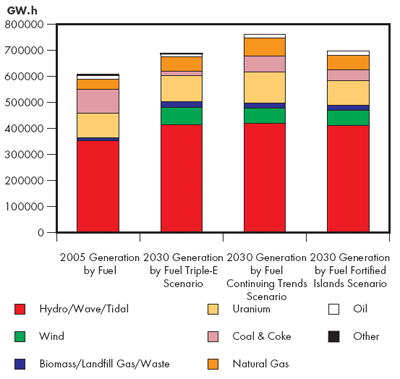
High natural gas prices and concerns about security of supply favours coal-fired generation in the Fortified Islands Scenario, while lower natural gas prices and concern about emissions favour natural gas generation in the Triple E Scenario. The Triple E Scenario also favours the development of alternative sources of energy, with more wind and biomass than the other scenarios as well as pilot projects for wave and tidal power. This scenario also includes IGCC power plants with CO2 capture and storage (CCS) technology in Alberta and Saskatchewan after 2019.
Interprovincial exchanges of energy and exports to the United States increase in most scenarios. With demand peaking and then beginning to decline, exports and interprovincial trade increases dramatically in the Fortified Islands and Triple E Scenarios, although the drivers are dissimilar. In Fortified Islands, wind and hydro power are seen as safe and secure from high fossil fuel prices. In Triple E, the advantage of wind and hydro power stems from their being a GHG-neutral form of generation. Higher demand in Continuing Trends is met primarily with increased hydro generation. A general tightening in domestic supply reduces opportunities for export in this scenario.
New transmission is required in all scenarios - within provinces to support new generation, between provinces to enable increased interprovincial interchange, and, between Canada and the United States to enable increased exports. In all scenarios, some new construction is included as existing plants reach the end of their 40-year economic life. Large hydro developments in Newfoundland and Labrador, Quebec, Manitoba and British Columbia may arise, requiring substantial and unprecedented additions to transmission systems.
Coal
Overall, Canadian coal demand decreases and net exports increase resulting in a decline in Canadian production across all three scenarios (Figure AO.13). Both total production and demand is highest in the Continuing Trends Scenario. In Triple E, thermal demand is lower and utilizes IGCC and CO2 capture and storage. Low economic growth and high prices lead to lower thermal demand in Fortified Islands. The closure of Ontario's coal-fired plants is a key influence on the short- and long-term imports of thermal coal, while exports of metallurgical coal are expected to grow with the expansion in the international iron and steel industry. The potential for IGCC and CCS, and the success of other new coal technologies to address environmental concerns, depends on cost and acceptability relative to generation alternatives. Net exports remain positive and increase in all scenarios.
Figure AO.13
Canadian Coal Production and Disposition, 2005, 2015 and 2030
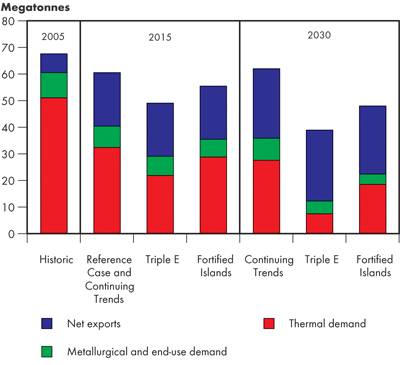
(The sum of Canadian thermal, metallurgical, and end-use coal demand as well as exports is equal to Canadian production).
Greenhouse Gas Emissions[6]
To a large extent, GHG emissions are an outcome of energy demand trends, therefore, GHG emissions increase with growing demand. Growth in GHG emissions ranges between -0.1 to 1.5 percent per year (Figure AO.14). Energy demand is rigid in the short to medium term as it is shaped by established industries, devices, services, and habits. In the Reference Case, GHG emissions are expected to increase by 1.5 percent per year. In Continuing Trends, GHG emissions grow at 1.2 percent per year, reflecting the slightly lower economic growth. In the Fortified Islands Scenario, GHG emissions are expected to grow at 0.6 percent per year. The slower growth in this scenario, compared to history, is a direct result of higher energy prices and slower income and economic growth in the Canadian economy, excluding the oil and gas producing sector. In the Triple E Scenario, GHG emissions are expected to decrease by 0.1 percent per year between 2004 and 2030. This decrease is a result of policies directed at balancing energy use, environmental impacts, and economic growth.
[6] The historic GHG emissions numbers are aligned with Canada's GHG Emission Inventory, which includes both energy and non-energy emissions. In the outlook period, non-energy emissions are grown at the rate of the economy and included in the other category.
Figure AO.14
Canadian Total GHG Emissions
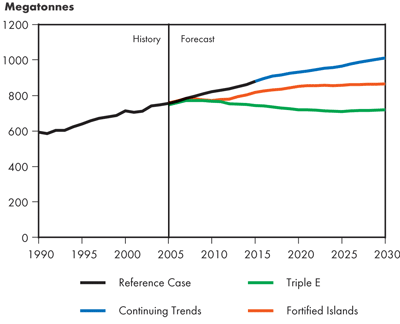
Figure AO.15
Canadian GHG Emissions Intensity
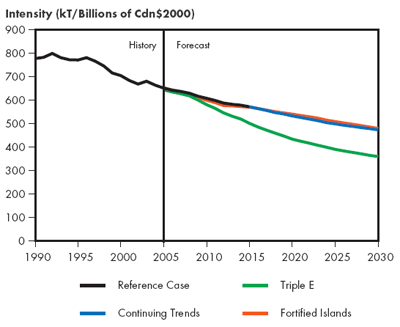
GHG emissions intensity across the Reference Case and all scenarios continues to decline implying fewer GHG emissions are released to produce the same amount of goods and services (Figure AO.15).
Recent federal government announcements have targeted a reduction in Canadian GHG emissions by 20 percent below 2006 levels by the year 2020. There are considerable uncertainties surrounding the means to achieve this reduction. In all scenarios examined, Canada partially achieves the '20 percent by 2020' goal set by the Government. There are numerous paths to GHG emission reductions. These paths will have potentially major impacts on technological choices, configuration of our cities and energy systems, as well as consumer behaviour. Identification of the specific mechanisms that will allow us to achieve this target has proven to be unattainable in the context of this analysis.
This report is an analysis of Canada's possible energy futures. As such, the report focuses strictly on GHG emission reductions from energy-related activities in Canada (e.g., energy efficiency measures, improved energy management systems or investment in CO2 capture and storage). The analysis does not directly focus on GHG emission reduction strategies. For example, the analysis does not incorporate two potential sources of GHG emissions reductions: (a) non-energy-related emission reductions such as carbon sequestration in agriculture and forestry; and (b) GHG emission reductions from international mechanisms such as access to Kyoto's Clean Development Mechanism, or international CO2 emissions trading regimes. Consideration of these and others as part of a full spectrum of GHG reduction strategies could go a long way in contributing to Canada meeting its target of 20 percent by 2020.
It is important to note that significant uncertainty exists over how consumers and technology will react to energy demand management and GHG emission programs and policies. At the time of writing, the most up-to-date information was included in the analysis; however, climate policy and technological advancements rapidly evolve. More rapid progression of technology than assumed in this report, or a higher willingness of consumers and industry to make significant lifestyle and production changes, would result in a more ambitious GHG emission reduction profile than reflected in the current analysis.
Our conclusions on GHGs demonstrate clearly that for Canada to achieve its 2020 goals, important and fundamental changes in the way we live and in the way we produce goods and services need to take place. Ultimately the path pursued will be the subject of major societal and political debates over the next few years in order to balance priorities on economic, environment and energy issues.
Conclusions
Canada's Energy Future highlights the many challenges and opportunities facing both the energy sector and individual Canadians, both today and in the future. The scenarios considered explore a wide range of potential energy market outcomes. A high level overview of the key assumptions and quantitative results is captured in Table AO.1.
Table AO.1
Summary of Key Assumptions and Quantitative Results
| Real GDP | Energy Prices | Energy Demand | Oil & Gas Production | GHG Emissions | |
|---|---|---|---|---|---|
| Reference Case (2004-2015) |
2.9% | Oil: $50/bbl Gas: $7/MMBtu |
1.8% | Oil: 4.4% Gas: -0.9% |
1.5% |
| Continuing Trends | 2.5% | Oil: $50/bbl Gas: $7/MMBtu |
1.4% | Oil: 2.3% Gas: -1.8% |
1.2% |
| Triple E | 2.2% | Oil: $35/bbl Gas: $5.50/MMBtu |
0.3% | Oil: 0.7% Gas: -4.8% |
-0.1% |
| Fortified Islands | 1.8% | Oil: $85/bbl Gas: $12/MMBtu |
0.7% | Oil: 3.0 Gas: 0.4% |
0.6% |
| (Annual Average Growth Rate from 2004 to 2030 [% per year] unless otherwise specified) | |||||
Key insights garnered from the analysis can be summarized under five major themes.
1. Energy Markets and Resources
Canadian energy markets are expected to function well with energy prices acting to ensure there is sufficient energy supply to meet energy demand. Prices in the long-term are expected to be higher than those experienced historically. Overall, it appears that North American and global economies are adjusting to higher prices recently experienced.
Availability of energy resources in the future is not expected to be an issue. The type and mix of energy resources will be determined by the level of energy prices. Overall, Canadian energy supply and the fuel mix is quite price-responsive, creating a broad range of outcomes in response to alternative price trajectories and the socioeconomic environment modeled in the three scenarios.
2. Energy Supply, Demand and Exports
Fossil fuel energy continues to be the dominant source of supply, although non-conventional and non-fossil fuel supplies begin to play a larger role. Continued fuel diversity is expected to be part of the energy balance in Canada. All scenarios depict a fuel mix that is mostly conventional at the base, but varies in terms of additions from emerging and alternative technologies and fuels.
The mix of electric power generation will see significant changes as the use of wind power, nuclear power and clean coal technologies are all expected to grow.
While energy supply is quite price-responsive, energy demand is not. Demand continues to be inelastic in the short term due to the long life of the existing stock of buildings, vehicles and urban design of Canadian cities. However, in the long-term, there is opportunity for demand reductions in response to targeted policies and programs, including improvements in energy efficiency.
Total Canadian net energy exports are expected to increase in the future. However, growth varies by commodity and scenario. Oil and electricity exports increase in all scenarios, while natural gas net exports increase only in Fortified Islands. The increase in oil exports is a direct result of growing oil sands production in all scenarios. These changes will have implications for supply infrastructure.
3. Energy Interactions with the Economy and Environment
The state of the economy continues to be an important driver for the energy system, and alternative macroeconomic projections in the three scenarios lead to different energy outcomes, especially in energy demand. Macroeconomic growth in all scenarios is lower than observed in recent history, largely due to decelerating population growth and its implications for adequate labour and skill sets. These will need to be compensated by improvements in productivity and/or increased immigration.
Canadians are concerned about climate change. Numerous policies and programs are being developed at the federal and provincial levels to reduce GHG emissions. Addressing climate change in a meaningful way in Canada requires early action and utilization of all the strategies at our disposal. The GHG emissions per unit of energy used declines in all scenarios, but the rate of decline varies based on policies and programs considered.
4. Building Blocks for Canada's Energy Future
Technology can offer solutions to many challenges in the energy system. While technology makes incremental inroads into Canada's energy future, the direction, pace, and extent of these changes vary across scenarios. The technology push in Fortified Islands is most evident on the supply side. In Triple E, technology is inextricably tied to efficiency and GHG emission reductions.
'Smart' policy is required to help optimize multiple objectives of economic growth, environmental sustainability, and responsible development of the energy sector. Policy frameworks that extend (within and beyond) provincial borders will need to be constructed to consider wide regional differences with respect to energy and emissions, evolving energy supply systems, and a changing global environment. Canadians have a critical role to play in developing future policy by providing direction in terms of the objectives we would like to see pursued.
Major investments are needed in the next decade to develop new sources of energy and meet the growth in energy demand as well as replace the ageing infrastructure. Over the longer term, the infrastructure requirements and issues are more influenced by circumstances of the scenario, including implications arising from continued diversity of fuel mix. All infrastructure developments will need to take into account broad environmental concerns during construction and operation. New approaches are required to resolve differences between developers and local interests in order to improve the predictability of project completion. In some cases, this may include improving clarity in the regulatory and public engagement processes, while in other cases it may require more use of 'single window' approaches when several jurisdictions are involved.
As the requirement to renew and expand our energy infrastructure increases to meet the growing and diverse needs for energy, greater public engagement and acceptance for these initiatives will be needed. A balance will need to be established between public acceptance and the need for timely decision making. In addition, all stakeholders, including industry and governments, will need to work together to secure that greater acceptance.
High-quality data forms a solid foundation for supply and demand analysis, such as the analysis for Canada's Energy Future. As energy issues become increasingly complex, there emerges a need for enhancements and improvements to existing statistical databases to empower decision-making.
5. Canada's Energy Future
The analysis suggests significant change in several elements of the energy system[7]. A long-term energy vision and strategy for Canada is needed to balance multiple objectives. This plan must be well integrated at the regional level, consider environmental issues and economic growth, and be developed with input from Canadians. Only then will we be able to overcome the challenges ahead and take advantage of the opportunities available.
[7] The energy system is defined as how Canadians produce and consume energy.
The NEB plans to contribute to this debate by continuing to pursue our vision of being an active, effective and knowledgeable partner engaging Canada in the discussion of Canada's energy future.
Foreword
The National Energy Board (NEB or the Board) is an independent federal agency that regulates several aspects of Canada's energy industry. Its purpose is to promote safety and security, environmental protection and efficient energy infrastructure and markets in the Canadian public interest[*] within the mandate set by Parliament in the regulation of pipelines, energy development and trade. The main functions of the NEB include regulating the construction and operation of pipelines that cross international or provincial borders, as well as tolls and tariffs. Another key role is to regulate international power lines and designated interprovincial power lines. The NEB also regulates natural gas imports and exports, oil, natural gas liquids, and electricity exports, and some oil and gas exploration on frontier lands, particularly in Canada's North and certain offshore areas.
The NEB collects and analyzes information about Canadian energy markets through regulatory processes and market monitoring. From these efforts, the Board produces publications, statistical reports and speeches that address various market aspects of Canada's energy commodities. The Energy Market Assessment (EMA) reports published by the Board provide analyses of the major energy commodities. Through these EMAs, Canadians are informed about the outlook for energy supplies and demand in order to develop an understanding of the issues underlying energy-related decisions.
This EMA report, titled Canada's Energy Future, examines the long-term energy demand and supply possibilities within Canada. The main objectives of this report are to:
- provide unbiased, relevant, comprehensive, expert analysis on energy supply, demand and its economic and environmental implications to serve as a standard of reference for parties interested in Canadian energy issues and trends;
- provide stimulus for discussion with and amongst stakeholders, both during and after the completion of the report on emerging energy issues of national importance; and,
- inform decision makers of key risks and uncertainties facing the energy future and advise them of regulatory and other issues that need to be addressed.
While preparing this report, the NEB conducted a series of formal and informal meetings with energy market experts and other interested parties. The NEB appreciates the information and comments provided and would like to thank all participants for their time and expertise. The NEB would also like to thank the numerous dedicated staff members that contributed directly and indirectly to the completion of this report.
If a party wishes to rely on material from this report in any regulatory proceeding before the NEB, it may submit the material, just as it may submit any public document. Under these circumstances, the submitting party in effect adopts the material and that party could be required to answer questions pertaining to the material.
Questions and comments regarding this EMA can be directed to the following:
General report:
Abha Bhargava
Energy demand:
Abha Bhargava
Oil and natural gas liquids:
Cliff Brown
Bill Wall
Gas supply:
Paul Mortensen email: paul.mortensen@cer-rec.gc.ca
Greenhouse gas emissions:
Abha Bhargava
- Date modified:
